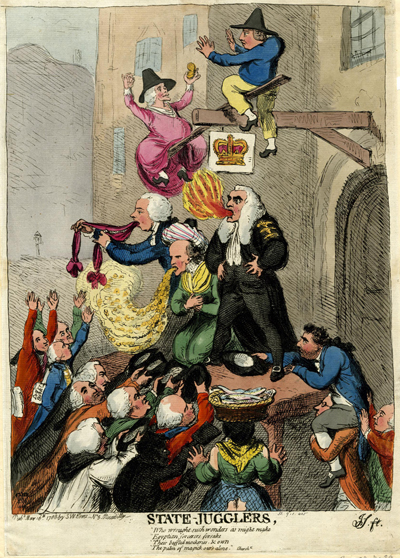State Jugglers
This is one of ten or more prints by Gillray spawned by the impeachment trial of Warren Hastings beginning in February 1788. State Jugglers depicts a scene that would have been familiar to all of Gillray's audience: an entertainment by a troupe of performers on a raised stage conveniently erected before a tavern where the audience and performers could slake their thirst between acts

© Trustees of the British Museum
In this case, the featured performers include three of the most powerful figures of the day: Prime Minister William Pitt, magically pulling the ribbons of ceremonial honors and promotions from his mouth;* Warren Hastings, former Governor General of India, spewing a stream gold coins to ensure the right verdict in the pending case against him, and Edward Thurlow, the fire breathing Lord High Chancellor, famous for the kind of rough and ready invectives we can see listed among the flames, and, as portrayed by Gillray in prints like Blood and Thunder and The Westminster Hunt, someone who often provided protection for Hastings.
All three of them, however, are called "Jugglers," a term much less neutral than it is today. Johnson's Dictionary of the English Language (1755), for instance, defines "juggler" as "One who practises slight of hand; one who deceives the eye by nimble conveyance, and "A cheat; a trickish fellow." And they are, more specifically, "State Jugglers,"—tricksters performing at the behest of the Crown. Indeed, the King and Queen as Punch and Judy are presumed to preside as both overseers of the actions below and performers in their own right in a somewhat obscene seesaw act of weight and influence.
The crowd at this entertainment, however, is mostly no more innocent than the performers on stage. The suppliants on the far left grasp for honors and preferments from Pitt, the ones in the center hold out their hats for bribes from Hastings, and those on the right (not satisfied with holding out their hat for stray cash) appear to be climbing onto the stage for a would-be next act.
According to the British Museum commentary, the first group (from left to right) consists of the cross-eyed John Wilkes, Sir Alexander Hood with a Log Book, and an unknown gentleman. By the time of this print, Wilkes was a firm supporter of Pitt, so it would have made sense to group Wilkes with Pitt. And Hood was certainly the beneficiary of Pitt's magic, having been made a Knight of the Order of Bath in 1788.
According to the same source, the second group features Henry Dundas, Lord Shelburne, Thomas Townshend Viscount Sydney, a bishop, and perhaps Lord Derby—all of them wishing to be bought by Hastings. Next to them, a lowly chimney sweep and a fishmonger are the only members of the audience not clamoring to be paid off.
On the far right, Charles James Fox supported by Burke and Sheridan seems to be scrambling onto the stage as a possible next act. One of the incentives, of course, for attacking Hastings was to embarass Pitt and bring about the downfall of the current administration.
Beneath the image is a caption derived with some changes from Book IV of The Ghost by the poet and satirist Charles Churchill.
| The Ghost | Jugglers |
|---|---|
|
Then Fancy, with unbounded sway, Revell'd sole mistress of the day, And wrought such wonders, as might make Egyptian sorcerers forsake Their baffled mockeries, and own The palm of magic hers alone. |
Who wrought such wonders as might make Egyptian sorcerers forsake Their baffled mockeries, & own The palm of magick our's alone |
Coupled with its title, the caption of this print is deeply cynical. It suggests that in the field of political trickery and deception, England is not just competitive, but it takes the prize. Ironically, that condemnation includes Gillray himself, for he has signed the print with a final trick of his own, the faux logo of his major competitor in satiric prints, James Sayers.
*Gillray fan and Magician Ian Keable sent me the following fascinating note about about Pitt's trick. "You might be interested to know that the 'trick' that William Pitt is performing, of pulling ribbons out of his mouth, was first explained in Henry Dean's The Whole Art of Legerdemain: Or, Hocus Pocus in Perfection, published in 1763. The title of the trick was: 'How to pull innumerable Ribbons out of your Mouth, of what Colour your please'. Amusingly the author described it as 'somewhat a stale Jest' which suggests it had been performed for many years before that."
Sources and Reading
- Commentary from the British Museum on State Jugglers.
- Draper Hill, The Satirical Etchings of James Gillray, 1976, #15.
- Nicholas K Robinson, Edmund Burke: A Life in Caricature, 1996
- "Henry Dundas, 1st Viscount Melville," Wikipedia
- "Charles James Fox," Wikipedia
- "Warren Hastings," Wikipedia
- "Alexander Hood, 1st Viscount Bridport," Wikipedia
- "William Petty, 2nd Earl of Shelburne," Wikipedia
- "Frederick Montagu," Wikipedia
- "William Pitt the Younger," Wikipedia
- "Richard Brinsley Sheridan," Wikipedia
- "Thomas Townshend, 1st Viscount Sydney," Wikipedia
- "Edward Thurlow, 1st Baron Thurlow," Wikipedia
- "John Wilkes," Wikipedia
- "Charles Churchill (satirist)," Wikipedia
- Charles Churchill, The Ghost: Book IV
- Thomas Wright and R.H. Evans, Historical and Descriptive Account of the Caricatures of James Gillray #39.
- Thomas Wright and Joseph Grego, The Works of James Gillray, the Caricaturist; With the History of His Life and Times, p. 100.
Comments & Corrections
NOTE: Comments and/or corrections are always appreciated. To make that easier, I have included a form below that you can use. I promise never to share any of the info provided without your express permission.